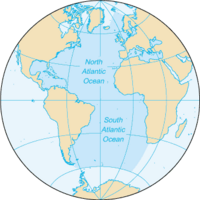
Photo from wikipedia
Abstract At the height of its extent, during strong glacials, the Palaeo-Agulhas Plain (PAP, south coast of South Africa) was the size of Ireland, sometimes doubling the size of the… Click to show full abstract
Abstract At the height of its extent, during strong glacials, the Palaeo-Agulhas Plain (PAP, south coast of South Africa) was the size of Ireland, sometimes doubling the size of the extant Cape Floristic Region (CFR). During strong interglacial climates, the PAP was mostly submerged and its ecosystems destroyed or restricted to small slivers. Scientists have largely ignored the PAP, presumably because it is submerged. We argue the PAP contributed to the diversification of the mega-diverse CFR biota and was the most productive foraging habitat available to the early modern humans that inhabited the famous archaeological sites along the current coast. We synthesize the palaeo-archival evidence and modeling results from this special issue, and other results, and propose a general model for the Last Glacial Maximum PAP, and offer suggestions as to conditions during marine isotope stages (MIS) 6 and 4. Unlike the region today, the PAP included abundant nutritious grassland, savanna-like floodplains, numerous wetlands, and a soft and highly dynamic coastline. Grasslands dominated the northern plains and fynbos shrublands the southern plains, both cut by broad meandering rivers with extensive floodplain woodlands and grasslands. The high productivity of the northern sector PAP supported a diverse plains fauna and rich habitats for humans living along its northern fringe, and during MIS 4 they had access to large ungulates on the grasslands, coastal resources, and plant foods from the plain and interior. The Holocene and historical contact period provide our current model of human and ecological conditions in the CFR region, but should be interpreted as a low-resource outlier.
Journal Title: Quaternary Science Reviews
Year Published: 2020
Link to full text (if available)
Share on Social Media: Sign Up to like & get
recommendations!